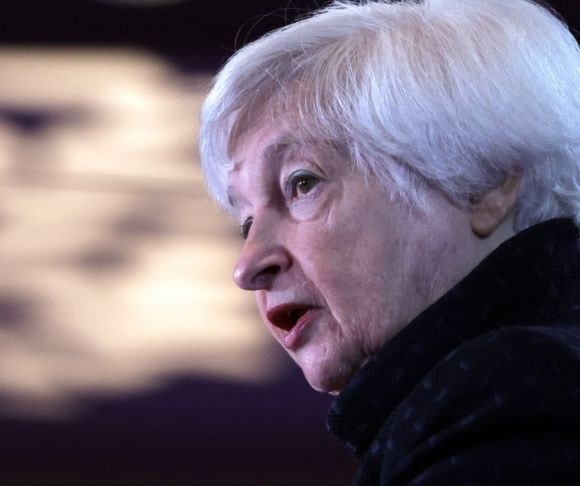The US Treasury Department’s bank account at the Federal Reserve is running low on funds. Secretary Janet Yellen has been trying to prevent the federal government from defaulting, employing a series of extraordinary measures since January, when Washington hit its debt limit of $31.4 trillion. As a result, the US Treasury might soon face an NSF (nonsufficient funds) charge as the public ledger shrinks unless lawmakers and the White House reach a last-minute agreement to raise the debt ceiling. But the clock is ticking.
US Treasury Funds Shrinking
According to the Daily Treasury Statement, the Treasury General Account Opening Balance on May 18 was $68.332 billion, down from $94.629 billion on May 17. This was also down significantly from the beginning of the month when the operating cash balance sat at $316.381 billion.
Experts predict that the US Treasury’s bank account will likely receive a substantial injection on June 15 from tax payments. But Yellen has repeatedly warned that the X-date – when the department can no longer meet its obligations – could be as early as June 1, mainly because of the growing TGA outflows.
House Republicans and the Biden administration are entrenched in negotiations. Both sides have been involved in stop-and-start talks, leaving some concerned that a deal might not be reached in time to avoid a default. So far, the global financial markets are not in panic mode. But the closer Washington inches toward June 1 without an agreement, the more sweat will fall from investors’ foreheads.
As Liberty Nation’s James Fite reported about the May 19 deliberations:
“Friday’s stop-and-go debt limit negotiations ended with no sign of progress and no future meetings on the matter scheduled. The GOP had paused the talks earlier in the day, presumably a sign the proceedings were going nowhere fast, but negotiators came back to the table in the evening for another go at it. While this might have temporarily raised hopes, it now seems those efforts were in vain.”
Tick tock.
Don’t Cry for Me Argentina

(Photo by Claudio Santisteban/picture alliance via Getty Images)
Many Americans might be too busy dealing with their own inflationary challenges to care about what is happening in South America, but Argentina is suffering from catastrophic inflation, which soared to a 30-year high of 100% in April. This is the third-highest level in the world, behind only Venezuela and Zimbabwe. Buenos Aires plans to tackle the cost-of-living collapse by raising the benchmark interest rate by six percentage points to 97%. Still, market analysts are doubtful that this will achieve much for the country ostensibly entrenched in a perpetual crisis.
But while policymakers purport that the dramatic rate hike will revitalize foreign investments in the Argentine peso, the consensus is that the socialist government has already lost the inflation fight. To put this into context, one US dollar equals 231.50 Argentine pesos. Moreover, many citizens are finding more value in the material used to produce peso coinage than the currency itself.
How did it get this way? Liberty Nation reported in 2021 that Argentina’s never-ending financial disaster was reignited in 2019 when President Alberto Fernandez won the election, initiating an exceptional selloff in government bonds that were later defaulted on. Then, despite no longer being able to access capital markets, the Fernandez administration went on a spending binge during the coronavirus pandemic, turning on the printing presses to finance the stimulus and relief measures. In addition, skyrocketing energy and food prices exacerbate the inflationary mess.
Drill, Baby Drill? Not Exactly
US crude oil production has stagnated since November 2022, ranging between 12 and 12.3 million barrels per day (bpd), according to the Energy Information Administration. This is still below the pre-pandemic high of 13.1 million bpd. Moreover, the Baker Hughes Total Rig Count has been on a downward trajectory for the past seven months, sliding to a one-year low of 720 for the week ending May 19.
 Was Pioneer Natural Resources CEO Scott Sheffield right when he told CNBC in March that the US will never reach a record in crude production “ever again”? The latest reports from industry observers and experts on the ground are that drilling in key shale energy regions is leveling off. Plus, the number of crews completing unfinished wells has been steadily falling, too.
Was Pioneer Natural Resources CEO Scott Sheffield right when he told CNBC in March that the US will never reach a record in crude production “ever again”? The latest reports from industry observers and experts on the ground are that drilling in key shale energy regions is leveling off. Plus, the number of crews completing unfinished wells has been steadily falling, too.
There is one thing for certain: The nation’s emergency oil reserves – the Strategic Petroleum Reserve (SPR) – continue to shrink. Although the White House has repeatedly pledged to replenish inventories, there have been seven consecutive weekly drawdowns since the end of March, declining below 360 million barrels. Since President Joe Biden took office, the SPR has cratered by about 44%.
But if conditions are generally bullish for black gold, why are prices still hovering around $70 a barrel? For now, investors are dismissing the solid fundamentals and concentrating on several short-term factors, including the banking turmoil, a resuscitation of the US dollar, and growing recession fears. Analysts anticipate that if prices fail to rally, the Organization of the Petroleum Exporting Countries (OPEC) and its allies, OPEC+, might choose to remove more barrels of oil from the international marketplace. Once again, if this move pushes West Texas Intermediate (WTI) and Brent contracts higher, this could add to inflationary pressures at home and abroad. Of course, this could be avoided if the US embraced the mantra of “drill baby drill.”




